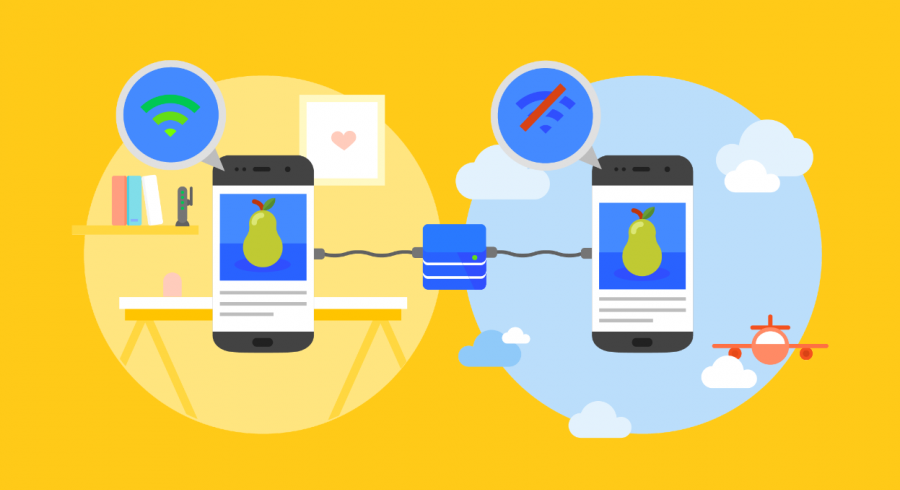The buzz about PWA is everywhere and we hear more and more often: “PWAs are the future of native apps”. But how much of it is true?
Since the advent of the mobile technology, the habits of internet users have evolved remarkably, forcing the webmasters to improve their creativity in order to offer an even-more suitable content to the users. Mobile users exceeded computer users in 2016, pushing the focus more strongly on the needs of the mobile users. In 2018, the mobile app market is saturated and new solutions are needed to meet the users’ requirements. In this way, Google introduced, in 2016, the Progressive Web Apps (PWAs). Their main objective is to work on the web technology to provide, in the best possible way, a native experience to users, including the limitations that come with it.
What are PWAs?
Progressive Web App is, as its name indicates, a new form of “web app” (or web page) where its “Progressive” means that these new apps will degrade gracefully to “regular web apps” when the platform (browser) doesn’t support this feature. In other words, a progressive web app is a web app that can appear to the user in the same way as native apps or mobile apps, without any constraints.
Why PWAs?
Certainly, native apps offer a high user experience in terms of quality. Users have a higher engagement degree with native apps, which they find easy and fast. Utility apps such as banking, TV or mobility for example are used frequently, so users prefer having them as native apps, although having too many of them won’t be convenient. However, if we take into account the whole cycle including the access to the app store, the downloading, the configuration and updates, the experience starts to degrade, especially for apps that are only little used. Therefore, the competition and the level of requirements of mobile users keep on increasing. According to the Mobile Marketing Association, in the last semester of 2017, only 28% of mobile users have downloaded new apps on their mobile phone. A solution was required against the downloading of new apps, knowing that web pages are consulted three times more than mobile apps.
So the most attractive element of PWAs is the promise to manipulate them in the same way as a native application… without having to download them from the stores. When you open a PWA in your browser (in the exact same fashion as any other regular web), you are given the chance to save it locally to your device with a quick access icon in your homepage.
This means that PWAs can cache files locally, thus running offline.
What are PWAs good for?
The biggest advantage is that a PWA can be anything web: it doesn’t have to be necessarily an app; it could also be:
- Blog
- Marketing or advertisement site
- Personal or portfolio space
- News site
- Social media
- Shopping app
- Media player
- … and many more!
Anything that can run on a webpage can become a PWA!
What are its advantages?
PWAs are extremely simple for both users and designers. The process of creating a PWA from a web app is greatly simplified using tools that automatically check what is missing and once stored locally, can run offline by caching files. This can be very useful in the public transport or the plane for instance. You can save a PWA to your local device and access to it via your homepage, as for the native apps and therefore receive notifications. Another advantage is that you can locally store files to load much faster than regular web pages. You don’t need to deploy them via stores; you can share the link and users will have direct access. Furthermore, PWAs enjoy a significant engagement and re-engagement rates on users and a very low (or even the lowest) friction, meaning that there is no up-front installation required to use the app. Not only that, updates are possible but not mandatory, making the user experience absolutely effortless. Although they are not disclosed in the App Store, since PWAs are websites, they are discoverable using search engines. The classical web referencing SEO allows a first visibility to PWAs, which can not be neglected. Last but not least, PWAs are faster and cheaper in development times compared to the native apps. What else?
All in all, the main argument behind the use of PWAs is that users can experience an app-like experience without necessarily downloading it.
How is that possible?
From a technical point of view: there are certain requirements (for example using a PWA for more than a certain amount of time or regularly) which will then prompt the user “do you want to store this PWA locally?”.
What are the limits of PWAs?
Sadly, just like any other web app, PWAs have the same limitations and cannot access all the hardware features of your smartphone in the way that only a native app can do. Despite their progressiveness, there are many features that PWAs cannot access on the device, which makes them flawed compared to native apps. For example, the classical functionalities as messaging and calling are not accessible. In addition to that, other features such as calendar, contacts, geo-fencing, reminders or alarms are also impossible to reach. PWA also cannot access a device’s NFC, a means of nearby communication between two devices.
Thus, in certain cases, some of our clients prefer native apps to PWAs because they are easier to find on the device and to work with, after all.
But regardless of their limitations, Progressive Web Apps are evolving the web on the mobile by providing a native app-like experience to users, and this is not to be put aside.
AliExpress, Twitter Lite and many others…
AliExpress is an online retail service which aims to create a high-quality mobile experience accessible to a broad number of users. After the launch of its PWA, the conversion rate has increased by 104% for the new users. Plus, its website is visited two times more frequently than before and the time spent per session has also raised by 74%, illustrating the benefits of PWAs.
In addition to AliExpress, other well-known editors such as Forbes, Financial Times, Washington Post, l’Equipe, the Weather Channel… have chosen PWA, as well as other online retailers: Lancôme, WeGo,…
PWAs are even used by some internet giants as Twitter Lite or Google Maps Go. This allows them to easily offer their services to a broader public.
So are PWAs right now a valid alternative to hybrid and native apps?
It depends on what you want to achieve.
For apps that require intensive processing (VR, AR, OCR, AI, heavy CPU tasks, etc.) or access to some smartphone features (calendar, contacts, phone, sms, etc.), you should stick to native apps for a while.
For every other idea you might have (either a portal or app), PWAs are definitely the way to go because the value proposition is higher than the inconveniences.


